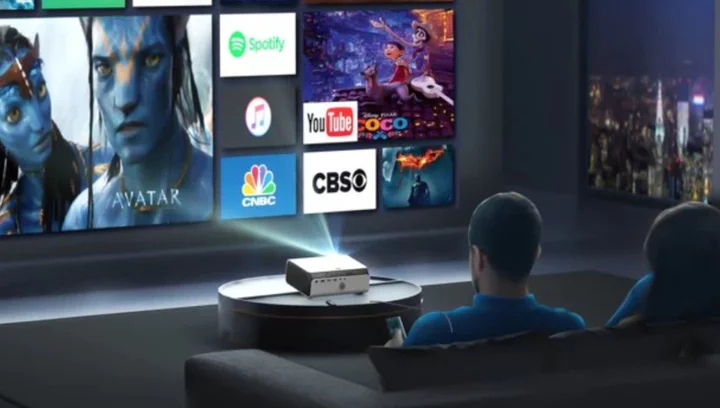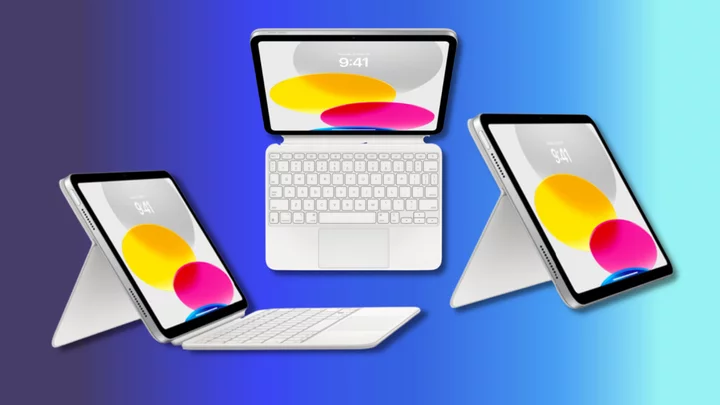Projectors have come a long way from the days when they were all essentially interchangeable for anything from business presentations to setting up a home theater, and the most useful way to categorize them was by their weight class. Today, you can break them down by any number of meaningful categories, including their imaging technology (LCD, DLP, LCOS, and even laser raster), light source (lamp, LED, laser, or hybrid), and most important, their intended use.
As projectors have become more widely used, they've also become more specialized. A model intended for showing business presentations in rooms with bright lighting, for example, needs higher brightness than one designed for watching movies in a dark room, but it doesn't need the same level of contrast or color accuracy.
In this guide, we'll first cover our favorite picks for a variety of needs, chosen from models we've tested. We'll also explain why we picked each one for that specific use. Then, we'll take you through the factors you should consider when shopping for a projector to help ensure you find the best match for whatever you plan to use it for.
If you've read through our reasons above for why we picked each model, you've probably noticed that they change depending on all sorts of factors, ranging from what you're planning to use the projector for, to your budget, to purely subjective questions like whether you find rainbow artifacts annoying. You need to take all of these issues into account in any buying decision, but a good place to start is with what kinds of images you plan to view.
There are two basic kinds of images to consider: data (meaning text and graphics) and photorealistic (photos, video, and film). Games generally have some aspects of both. Any projector can show any kind of image, of course, but a projector may handle one kind of image well without necessarily doing a good job with the other. You'll want a projector that’s optimized at least for the kind of images you plan to view most often, and ideally for every kind you expect to view.
Data projectors, also called business or education projectors depending on their target market, are designed to show business graphics, line drawings, presentations, spreadsheets, and PDF files. They’re optimized for conference rooms and classrooms, throwing a bright-enough image to stand up to ambient light on a large screen. Many can handle photorealistic images well enough to project short video clips in a presentation or even an acceptable image for, say, watching a movie in a classroom. But they are rarely good choices for full-length movies if you want anything approaching the quality you expect in a movie theater or when watching on a TV. They tend to favor brightness, which is important for standing up to ambient light, over contrast and color accuracy, which matters more for photorealistic images. They also tend to offer few or no options for adjusting color.
Home theater, home entertainment, and gaming projectors are all so similar to each other that one model is often marketed in two or three categories. These home-use projectors focus on color accuracy and contrast, usually adding controls to fine-tune color, reduce noise, sharpen images, and otherwise digitally enhance video and film.
Models listed as home theater projectors are typically optimized for traditional home theater viewing in a dark room. They tend to offer more accurate color, better contrast, and lower brightness than home entertainment projectors. Most don't include speakers. The assumption is that you'll set up a better external audio system in your home theater than any projector can fit into its case.
Home entertainment models are usually optimized for viewing in a family room or other space with ambient light. Many are also compact enough so you can easily move them outdoors to create the perfect backyard movie night. Compared with home theater models, they tend to sacrifice some color accuracy and contrast in favor of higher brightness. They also typically include built-in speakers.
Until recently, it was a given for almost all projectors that even if they included speakers, you should plan on using an external sound system to get decent audio quality. However, that's not always true today, largely thanks to two subcategories of home entertainment models. One is what we've dubbed "room-to-room portables." There are defined in part by offering robust audio, so you can move them around for ad hoc setup without having to lug a sound system with you also. Most are nearly cubical in shape, about twice as high as traditional projectors. They use the extra height for good-quality speakers, which are often chamber speakers. Most offer high enough volume to fill a large family room with more-than-acceptable sound quality.
The second category with good audio is sometimes billed as "laser TVs." These are built around a laser light source; a smart TV streaming feature, which can either be integrated or supplied as a dongle; and an ultra short throw (UST), which means they can throw a 100-inch or larger image with the projector just inches from a screen. Mount a screen on a wall, and the projector can sit on a table or entertainment center just below it. These laser-based UST models are wider than most other projectors. Virtually all offer audio that's at least comparable to what you would expect from a large-screen TV. Some take advantage of the width to add what amounts to a sound bar on the side facing away from the screen.
Gaming projectors are basically home entertainment models with greatly reduced input lag for speedier reaction time in gaming. Most are small enough to carry easily, and they usually include better-than-typical onboard audio for a projector. A few include separate gaming modes for first-person shooter, role playing, and sports games, with each mode automatically adjusting both audio and video settings to optimize both for each type of game.
Do You Need a Portable Projector?
Consider how portable the projector needs to be. You can find projectors with sizes and weights ranging from small and light enough to fit in a shirt pocket to large and massive enough to be suitable only for a permanent (usually mounted) installation.
If you want a data projector to carry to business meetings for presentations, or a home entertainment or gaming projector to take to a friend's house or set up in your backyard for a movie night, be sure to pick an appropriate size and weight—which is to say, a portable projector. If you'll be away from power outlets, check that the projector’s battery life is long enough for your needs.
What Resolution Is Enough in a Projector?
Projectors can scale images up or down, but that's usually best avoided, since it can distort the image. For any projector resolution up to and including WUXGA (1,920 by 1,200 pixels), you will generally get the best image quality by matching the projector’s native resolution (the number of physical pixels in the projector's display) to the source you plan to attach it to most often, whether that's a computer, video equipment, or a game console.
For projectors with 4K ultra-high definition (3,840 by 2,160 pixels), the rule is a little different. Current projectors built around 3,840-by-2,160-pixel imaging chips are still too expensive for most applications. The affordable alternative takes advantage of a technique called pixel shifting. It uses a native 1,920-by-1,080-pixel chip, generates more than one set of pixels for each frame in the video stream, and shifts the position for each set. The result is more pixels per frame on screen than are on the chip. Two sets double the number of pixels; four sets quadruple the number to a full 3,840 by 2,160. When done well, just doubling the number of pixels can deliver images that are indistinguishable from quadrupling them, at least at normal viewing distances from the screen.
Even 1080p projectors that can accept 4K UHD input handle it reasonably well. Because the higher resolution has exactly four times as many pixels as 1080p, the only loss in quality from scaling the image down will be the equivalent of a slightly soft focus. If the projector also supports HDR10 (the version of high dynamic range, or HDR, that's on discs and some streaming services, including Netflix) or HLG HDR (also supported by some streaming services), it can give you the advantage of HDR for improving image quality, even with 1080p resolution.
If you plan to show data images, you should consider the level of detail in the images. For a typical PowerPoint presentation, SVGA (800 by 600 pixels) may be good enough, and an SVGA projector will be much less expensive than one with a higher native resolution. For very detailed images, however, you’ll want to go up to 4K UHD.
For video, 4K UHD is generally the best choice, assuming you have a 4K UHD Blu-ray player, a 4K-capable streaming device, or another 4K UHD media source. But odds are you'll be watching a lot of 1080p material for the foreseeable future—particularly if you own a library of 1080p discs—and may occasionally be watching at even lower resolutions. So check how well the projector handles scaling up 1080p input.
Which Widescreen Format Is Most Important in Your Projector?
Most projectors today offer native resolutions that qualify as widescreen formats. You'll generally want to match the aspect ratio (ratio of image width to image height) of the projector's resolution to the images you'll be watching most often, although you can also view material in narrower or wider formats. As long as the input resolution is one that the projector can accept—a detail you can check in the projector specs—it will either scale the image to the projector's native aspect ratio, which means stretching or shrinking it as needed, or keep the image's aspect ratio to avoid distortion and add letterbox bars (black bars above and below for wider formats or to each side for narrower formats). Almost all projectors today include aspect-ratio settings to let you choose which approach to use. (Fun fact: adding black bars to the sides on an image is often called reverse letterboxing or pillarboxing.)
Note that the ability to show images with different aspect ratios than the projector's native resolution gives you some flexibility in matching the projector to the images you plan to watch. For example, you can use a native WUXGA projector, with its 16:10 aspect ratio, to watch movies or TV with a 16:9 aspect ratio. Keep in mind that if you set up a 16:10 projector to fill your 16:9 screen with the picture, you'll need a sufficiently wide black border at the edges to keep the letterbox bars from showing as brighter areas surrounding the screen.
How Bright Should the Projector Be?
There is no single best level for projector brightness, and brighter isn't always better. For a home theater projector you plan to use in a dark room, for example, 1,000 lumens or even less can easily give you a large, bright image, while 2,000 lumens may be so bright that it's hard on the eyes. On the other hand, for a portable data projector you expect to use in brightly lit locations or a home entertainment projector for your family room, 2,000 to 3,000 lumens is the right range in most cases. For large rooms, you'll want something even brighter.
For any situation, the ideal projector brightness depends on the ambient light level, the size of the image, and the material in the screen you're using. If you're setting up a projector for permanent installation, whether at home or in your office, your best bet is to buy from a knowledgeable seller who can help you pick a projector and screen material that will give you the right image brightness for the lighting conditions in the room at the screen size you want.
If you're trying to choose between two models, keep in mind that a small percentage difference in lumens—2,000 versus 2,200, for example—isn't significant. The perception of brightness is nonlinear, which means a 10% difference is hardly noticeable, and you need far more than twice as many lumens for a projector's image to appear twice as bright. Also, keep in mind that a projector's true brightness is often a little less than its rated brightness, and image quality is generally best in modes that are often as little as 40% of the projector's highest brightness.
Does Contrast Ratio Matter for Projectors?
Contrast ratio—the ratio between the brightness of the brightest white a projector can produce and the brightness of the darkest black—always matters, but the rating for the projector usually won't matter. All other things being equal, a higher contrast ratio produces more vibrant, eye-catching color, more shadow detail in dark areas on the screen (most important for video and film), and a more dramatic sense of three-dimensionality in two-dimensional photorealistic images.
However, contrast ratings are based on measurements in a dark room, so they don't tell you much about viewing in ambient light, where the darkest black you can get depends on how much light there is in the room. A projector that delivers a high contrast ratio in a dark room because of unusually dark blacks will deliver much lower contrast in ambient light, and a brighter projector that also has a higher black level in the dark will do poorly in a home theater but do well in a living room or office. There, the high black level won't be noticeable, while the higher brightness will let it stand up better to the ambient light.
Comparing contrast-ratio specs is somewhere between challenging and pointless. Different manufacturers use different approaches to measuring contrast, and some even measure it differently for different models. There are also other factors—including video processing and auto-irises that change image brightness based on the content of the image—that increase your subjective sense of how good the contrast is but don't affect objective measurements. The best way to find out how good the contrast is for any given projector—short of seeing it yourself—is to look for reviews that discuss contrast in different settings.
How Do You Plan to Connect Your Projector?
To connect a projector to a video source, you obviously need to match the projector’s inputs with the source’s outputs. But given a choice, a digital connection is preferable to an analog connection.
Almost all current projectors include at least one HDMI port, which is the preferred choice for video sources and many computers, unless you plan to connect over a wired or wireless network. Many projectors still offer a VGA (analog) connector for computers and component video, but few new computers have VGA output ports, and few new video sources offer component video.
Keep in mind that the HDMI version matters. Later versions support higher resolutions and more features than earlier versions. Make sure the HDMI version on the projector will let you take full advantage of the image sources you want to use, either by confirming it has the same HDMI version number as the image sources or that the manufacturer says it supports those specific features. You should also check the High-Bandwidth Digital Content Protection (HDCP) level. Virtually all 4K UHD HDR movies, for example, require HDCP 2.2 on both the player and the projector.
Note that some projectors' HDMI ports support Mobile High-Definition Link (MHL), which lets you project from older Android devices. This is becoming less common, however, since most newer Android devices can connect directly to the HDMI port via a USB-C-to-HDMI cable. A more useful extra today is that many current projectors support eARC on one of their HDMI ports, for connecting to an external audio system.
Many models also have Wi-Fi connectivity built-in or can provide it through an included or separately purchased wireless dongle that plugs into a USB or HDMI port. Many support projecting directly from USB memory or memory cards.
A growing number of projectors include internet streaming features, either built-in or through an included streaming HDMI dongle. You can also buy third-party dongles to add streaming to virtually any projector with an HDMI port. Some models, most often portables, offer USB-C ports, which can (but don't always) support DisplayPort and HDMI protocols. Here also, check before buying to make sure you know what video support—if any—the USB-C connector offers.
Which Imaging Technology Is Best in a Projector?
Today's projectors are based on one of four imaging technologies: digital light processing (DLP), liquid-crystal display (LCD), liquid crystal on silicon (LCOS), and laser raster. (Don't confuse laser raster projectors, which actually draw the images using lasers, with the much more common models that simply use lasers as a light source for another imaging technology, like DLP or LCD chips.)
Most DLP projectors and some LCOS-based pico (aka pocket-size) projectors—including both data and video models—use only one display chip, and project their primary colors sequentially rather than all at once. This can lead to rainbow artifacts, in which bright areas on the screen break up into little red-green-blue flashes for some people when they shift their gaze or when something moves onscreen. Those who are sensitive to this effect can find it annoying, particularly for long viewing sessions.
Three-chip LCD projectors are free from rainbow artifacts, because the three chips allow projection of all three primary colors at once. However, they tend to be bigger and heavier than comparable DLP models. Standard-size LCOS projectors, also rainbow-free, offer the best-quality images, but they tend to be bigger and heavier than either DLP or LCD projectors, as well as far more expensive. There aren't many laser raster projectors, so it's hard to make general statements about them. But the one clear advantage of using a laser is that the image doesn't require focusing.
What Kind of Light Source Is Best in a Projector?
There's a growing trend in projectors of moving from using lamps as light sources to using LEDs or lasers. For the moment, at least, there are advantages to each choice.
LEDs and lasers maintain a higher percentage of their initial brightness for longer. All light sources lose brightness over time, but lamps generally lose a large percentage in the first 500 hours of use, and decline slowly after that. LEDs and lasers tend to lose brightness more evenly over their entire lifetimes.
The initial price for a lamp-based projector will be lower, but the total cost can be higher if you keep it long enough to need a replacement for the lamp. If you plan to replace your projector with every new jump in resolution or other image technology, buying a series of lamp-based projectors will be more cost-effective. But if you plan to keep your projector as long as it works, the better buy will be an LED, laser, or hybrid model that won’t need an expensive lamp replacement.
What Is a Short-Throw Projector? Do You Need One?
If you want to cast a large image at a short distance from the screen, either because the room itself is a little small or to minimize the bother of people getting in front of the projector and casting shadows, you’ll need a short-throw or ultra-short throw projector. There are no universally accepted definitions for what counts as “short” or "ultra-short," but most short-throw projectors can cast an image about 6.5 feet wide from 3 to 6 feet away, while ultra-short-throw projectors generally need less than a foot. By comparison, most projectors with standard throws need to be roughly 9 to 13 feet away from the screen for the same image size, and long-throw projectors have to be even farther away.
The downsides of short-throw (and especially ultra-short-throw) projectors are that they are more expensive than traditional models with standard-throw lenses, and they are more likely to have noticeable variations in brightness or focus across the image. Ultra-short-throw models also require a particularly flat and stable screen. Even slight variations in the surface can distort the image and affect focus.
Does Your Projector Need Built-In Audio or 3D Support?
Not all projectors have onboard audio, and for those that do, the audio is sometimes all but useless—particularly with highly portable models. If you need sound for your presentations or for watching video, make sure that the projector has built-in audio that’s clear enough and loud enough to meet your needs. If not, consider using a separate sound system—often a good idea for home theater or home entertainment in any case—or powered external speakers. If you already have Bluetooth speakers, check whether the projector supports Bluetooth.
Then there's 3D. Showing images in 3D for educational, business, and home applications seems well past the boomlet it enjoyed a few years ago. But if you're a fan of 3D movies or have an application that requires 3D, it's still easy to find projectors that support it.
Several 3D technologies are available, so make sure any 3D projector you consider will work with the 3D source you want to use. A “3D-ready” designation usually means it will work only with 3D generated by a computer. If you have a collection of 3D Blu-ray discs, the designation to look for is usually "full HD 3D." And before you go shopping for 3D glasses, be sure to check which kind the projector supports. There are several types, including some proprietary versions.
So, What Is the Best Projector to Buy?
The summary up top, and the spec breakout below, outline our choices for some of the best projectors on the market for the most common situations and use cases. For full projector reviews and our latest coverage of the category, also check out our top models for home use, our picks for 4K projectors, and our favorite portable projectors.









